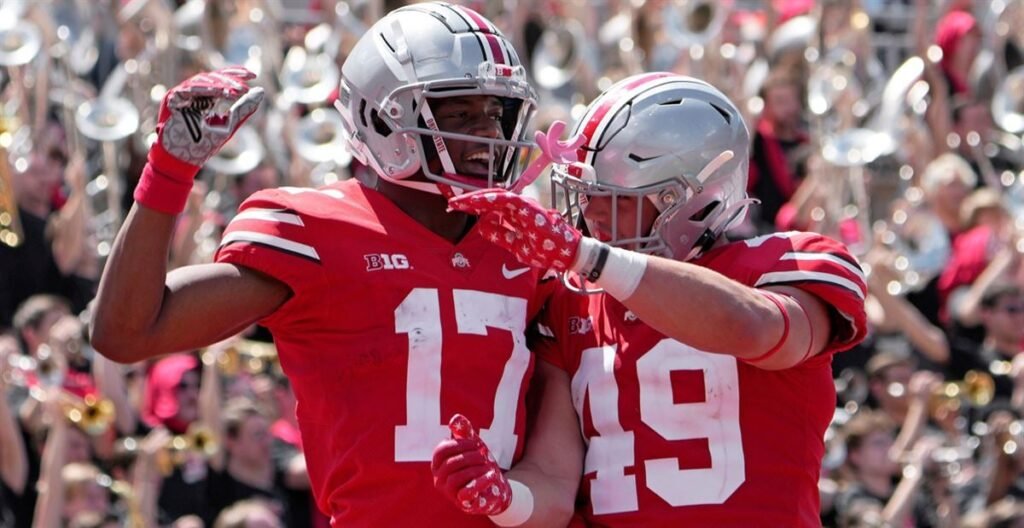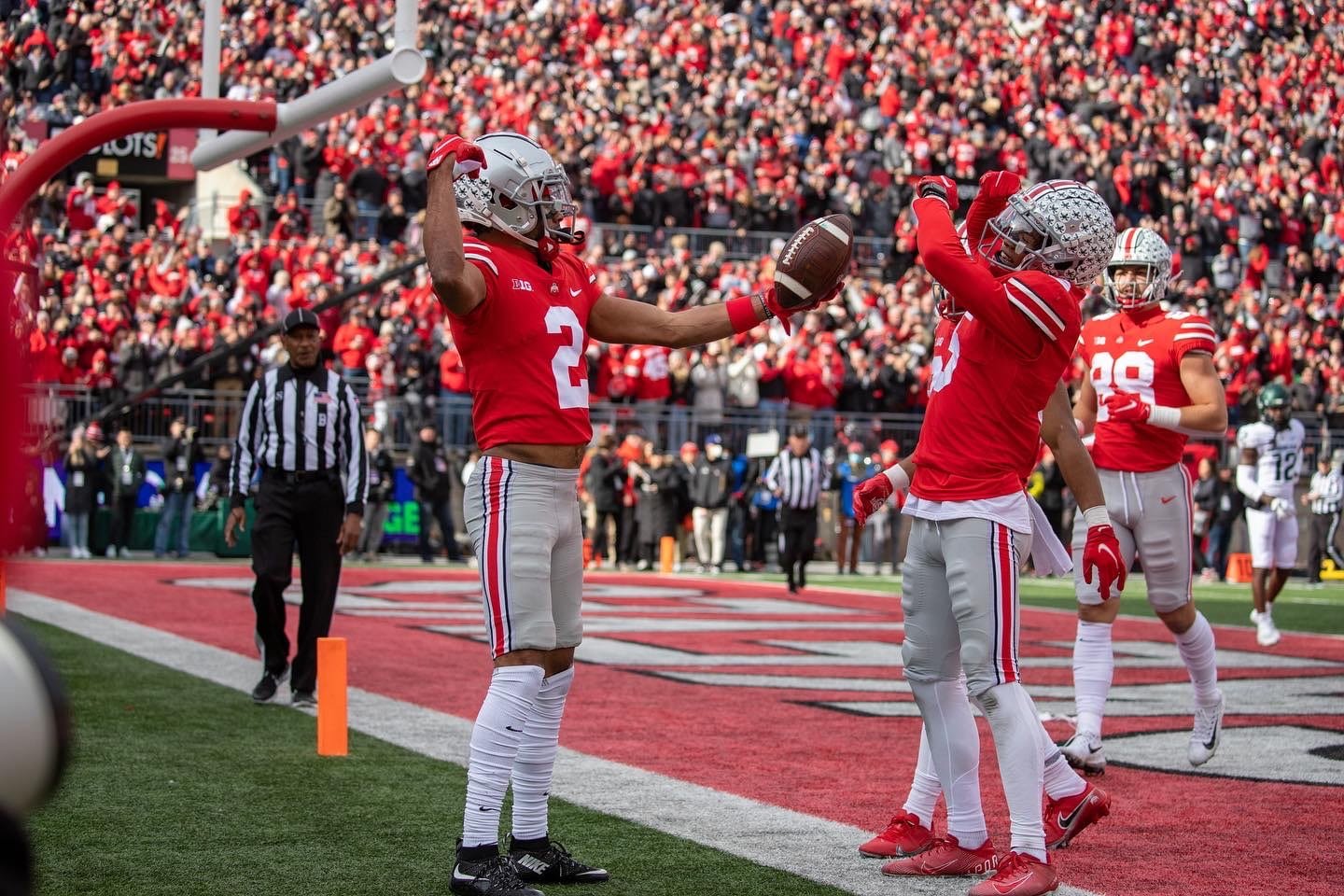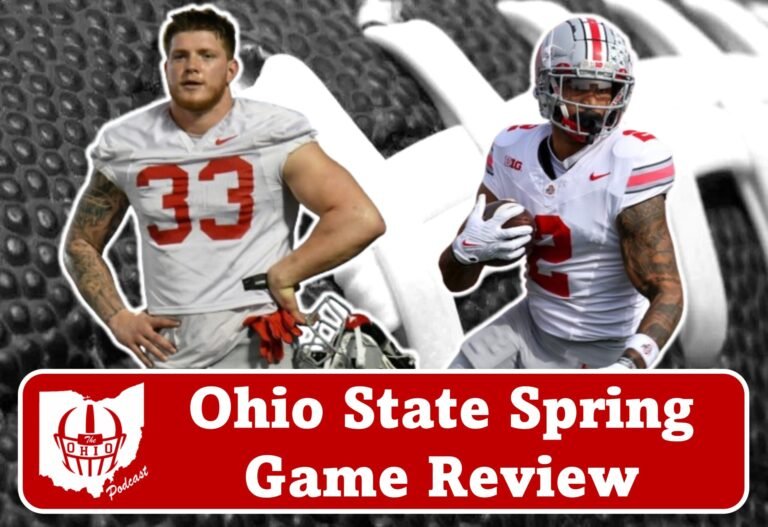
The Ohio State Buckeyes have had an eventful week, beginning with a national championship victory against the Notre Dame Fighting Irish on Monday. The team’s thrilling win, which marked their ninth national title in program history, has been the talk of college football, showcasing Ohio State’s dominance on the grand stage. Yet, amid the celebration and the positive momentum, the Buckeyes faced some unsettling developments involving key players and the transfer portal.
Reports surfaced earlier in the week from On3, revealing that another college football program attempted to poach two of Ohio State’s most promising wide receivers. One of the targets, sophomore standout Carnell Tate, was reportedly offered over $1 million to enter the transfer portal and leave the Buckeyes. The other player, freshman phenom Jeremiah Smith, received an even more substantial offer—a contract worth more than $4.5 million—to entice him into transferring. Such massive deals highlight the growing influence of Name, Image, and Likeness (NIL) agreements in college football and the fierce competition for elite talent.
The news of these offers understandably caused a stir among Buckeyes fans and college football analysts alike. For a program like Ohio State, which prides itself on developing NFL-caliber players, particularly at the wide receiver position, losing athletes like Tate and Smith would have been a significant blow. Over the past decade, Ohio State has become a powerhouse for producing elite receivers, with alumni like Michael Thomas, Terry McLaurin, and Chris Olave thriving in the NFL. Protecting the current roster is critical to sustaining that reputation.
Fortunately for Ohio State, just under a day after the offers were revealed, insiders Pete Nakos and Steve Wiltfong delivered some reassuring news: Carnell Tate would not be leaving Columbus. Despite the massive financial incentives dangled before him, Tate committed to staying with the Buckeyes for the 2025 season. This decision is a testament to the culture Ohio State has built, one where players feel loyalty and belief in the program outweigh monetary temptations.
Tate’s return is a significant win for Ohio State on multiple fronts. As a sophomore, he played a pivotal role in the Buckeyes’ offense during their championship-winning campaign. Over 15 games, he amassed 52 receptions, 733 receiving yards, and four touchdowns, placing third on the team in all three categories. His consistency as a playmaker was crucial, especially in high-pressure situations, as he helped the Buckeyes secure critical victories throughout the season.
Looking ahead, Tate’s presence becomes even more important considering the roster changes Ohio State will face in 2025. One of the biggest losses will be Emeka Egbuka, the Buckeyes’ second-most productive receiver, who is projected to declare for the 2025 NFL Draft. Egbuka’s departure leaves a sizable void in the offense, as his combination of speed, route-running precision, and versatility made him one of the most dynamic weapons in college football.
Adding to the challenge, Ohio State has also experienced notable attrition at the wide receiver position via the transfer portal. Among those departing are Kojo Antwi, a former four-star recruit, and Jayden Ballard, a promising three-star receiver. Losing depth in the receiving corps, particularly players with such potential, underscores why retaining Tate is such a massive win for the Buckeyes. Without him, the group could have been left nearly unrecognizable heading into the 2025 season.
Tate’s loyalty to the program also sets a positive example for younger players like Jeremiah Smith, who, despite receiving the largest offer of the two, has yet to show signs of leaving. Smith, a highly touted freshman and the top-rated receiver in the 2024 recruiting class, is expected to be a cornerstone of the Buckeyes’ offense for years to come. His decision to remain in Columbus could be heavily influenced by Tate’s example and the support system within the program.
The importance of stability within the wide receiver group cannot be overstated. Ohio State’s offensive success has long been built on the ability to develop and deploy elite pass-catchers, and the 2025 season will be no exception. With quarterback Kyle McCord poised to return for another year, having reliable targets like Tate and Smith ensures that the Buckeyes will remain a formidable offensive force. The chemistry between McCord and his receivers, which was evident throughout the 2024 season, will only grow stronger with another year of experience together.
Beyond the on-field impact, Tate’s decision to stay highlights the evolving dynamics of college football in the NIL era. The lure of substantial financial incentives from rival programs has introduced a new layer of complexity for coaching staffs, who must now focus not only on recruiting new talent but also on retaining their current players. For Ohio State, this means continuing to provide a supportive environment where athletes feel valued, both personally and professionally. Head coach Ryan Day and wide receivers coach Brian Hartline deserve credit for fostering a culture that prioritizes player development and loyalty.
The Buckeyes’ national championship victory and the retention of key players like Carnell Tate serve as a reminder of why Ohio State remains one of the premier programs in college football. The program’s ability to consistently compete at the highest level, attract top-tier talent, and navigate the challenges of modern college athletics is a testament to its leadership and tradition of excellence.
As the offseason unfolds, there’s little doubt that Ohio State will continue to be a major storyline in college football. The program’s success on the recruiting trail, combined with its ability to retain elite players, positions the Buckeyes for another run at the title in 2025. For fans, the prospect of watching stars like Carnell Tate and Jeremiah Smith develop into even greater talents is an exciting one. These players not only represent the future of Ohio State football but also embody the values and commitment that have defined the program for decades.
In a week filled with highs and lows, the Buckeyes have emerged stronger and more united. The national championship win against Notre Dame was a historic achievement, but the real victory lies in the team’s resilience and ability to overcome challenges, both on and off the field. With their core intact and a clear vision for the future, Ohio State is poised to remain a dominant force in college football for years to come.
For now, the focus shifts to preparing for the 2025 season, where expectations will be as high as ever. With Carnell Tate leading the way and a talented roster ready to step up, the Buckeyes are well-positioned to chase their 10th national championship. The road ahead won’t be easy, but if this past week is any indication, Ohio State is more than ready to rise to the challenge.



